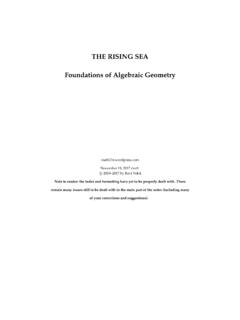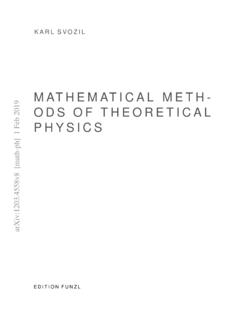Transcription of Section 1: Introduction to Geometry Points, L ines, and Planes
1 Section 1: Introduction to Geometry Points, Lines, and Planes Topic 1: Basics of Geometry - Part 1 .. 3. Topic 2: Basics of Geometry Part 5. Topic 3: Midpoint and Distance in the Coordinate Plane Part 7. Topic 4: Midpoint and Distance in the Coordinate Plane Part 11. Topic 5: Partitioning a Line Segment Part 1 .. 14. Topic 6: Partitioning a Line Segment Part 2 .. 16. Topic 7: Parallel and Perpendicular Lines Part 18. Topic 8: Parallel and Perpendicular Lines Part 19. Topic 9: Basic Constructions - Part 1 .. 21. Topic 10: Basic Constructions - Part 2 .. 23. Topic 11: Constructing Perpendicular Bisectors .. 25. Topic 12: Proving the Perpendicular Bisector Theorem Using Constructions.
2 27. Visit or search "Math Nation" in your phone or tablet's app store to watch the videos that go along with this workbook! 1. Section 1: Introduction to Geometry Points, Lines, and Planes The following Mathematics Florida Standards will be covered in this Section : - Know precise definitions of angle, circle, perpendicular line, parallel line, and line segment, based on the undefined notions of point, line, distance along a line, and distance around a circular arc. - Prove theorems about lines and angles; use theorems about lines and angles to solve problems. Theorems include: vertical angles are congruent; when a transversal crosses parallel lines, alternate interior angles are congruent and corresponding angles are congruent; points on a perpendicular bisector of a line segment are exactly those equidistant from the segment's endpoints.
3 - Make formal geometric constructions with a variety of tools and methods. Copying a segment; copying an angle; bisecting a segment; bisecting an angle; constructing perpendicular lines, including the perpendicular bisector of a line segment; and constructing a line parallel to a given line through a point not on the line. - Prove the slope criteria for parallel and perpendicular lines and use them to solve geometric problems. - Find the point on a directed line segment between two given points that partitions the segment in a given ratio. - Use coordinates to compute the perimeter of polygons and areas of triangles and rectangles. 2. Section 1: Introduction to Geometry Points, Lines, and Planes Section 1: Introduction to Geometry Points, Lines and Planes Points, lines, and Planes are the building blocks of Geometry .
4 Section 1 Topic 1. Basics of Geometry Part 1 Draw a representation for each of the following and fill in the appropriate notation on the chart below. What is Geometry ? Description Representation Notation A point is a precise Geometry means _____ _____, and it location or place on a involves the properties of points, lines, Planes and figures. plane. It is usually represented by a dot. A line is a straight path What concepts do you think belong in this branch of that continues in both mathematics? directions forever. Lines are one- dimensional. A plane is a flat, two-dimensional object. It has no thickness and extends Why does Geometry matter? When is Geometry used in the forever.
5 Real world? Definition Representation Notation A line segment is a portion of a line located between two points. A ray is piece of a line that starts at one point and extends infinitely in one direction. 3. Section 1: Introduction to Geometry Points, Lines, and Planes Definition Representation Notation A plane is a flat, two-dimensional object. It has no thickness and extends forever. An angle is formed by two rays with the same endpoint. The point where the rays meet is called the vertex. Parallel lines are two lines on the same plane that do not intersect. Perpendicular lines are two intersecting lines that form a 90 . angle. What can you say about multiple points on a line segment?
6 !"#$%&'!$! Segment Addition Postulate )*+, ,0+%&%. !20*304+ If three points, , , and , are collinear and is between and , then + = . 4. Section 1: Introduction to Geometry Points, Lines, and Planes Try It! Section 1 Topic 2. Basics of Geometry Part 2. 2. Consider the descriptions of points, lines, and Planes you have learned so far. Let's Practice! Use the word bank to complete the descriptions below. 1. Consider the figure below. Draw a representation of each one. Parallel Planes Coplanar Parallel Word Bank Lines Collinear Non-collinear Points that lie on Points that lie on Description the same plane the same line are are _____. _____. Select all the statements that apply to this figure.
7 O , , , and are coplanar in . o , , , and are collinear. o , , and are collinear and coplanar in . o lies on . o , and are coplanar in . Drawing o , , and lie on . o + = . 5. Section 1: Introduction to Geometry Points, Lines, and Planes Try It! 2. Plane contains and , and it also intersects only at point . Use the space below to sketch plane . For points, lines, and Planes , you need to know certain postulates. A postulate is a statement that we take to be automatically true. We do not need to prove that a postulate is true because it is something we assume to be true. Let's examine the following postulates A through F. A. Through any two points there is exactly one line.
8 B. Through any three non-collinear points there is exactly one plane. C. If two points lie in a plane, then the line containing those points will also lie in the plane. D. If two lines intersect, they intersect in exactly one point. E. If two Planes intersect, they intersect in exactly one line. F. Given a point on a plane, there is one and only one line perpendicular to the plane through that point. 6. Section 1: Introduction to Geometry Points, Lines, and Planes Section 1 Topic 3. Midpoint and Distance in the Coordinate Plane Part 1. Consider the line segment displayed below. 10 cm The length of is _____ centimeters. _____ is an amount of space (in certain units) between two points on a _____.
9 Draw a point halfway between point and point . Label this point . What is the length of ? What is the length of ? Point is called the _____ of . Why do you think it's called the midpoint? 7. Section 1: Introduction to Geometry Points, Lines, and Planes Let's Practice! 2. Consider the line segment below. 1. Consider with midpoint . (7 + 8) cm (9 8) cm a. If is 128 centimeters long, what is ? a. What can be said of and ? b. What is the length of ? b. If is 2 + 5 inches long and is 22 inches long, what is the value of ? c. What is the length of ? d. Is point the midpoint of ? Justify your answer. 8. Section 1: Introduction to Geometry Points, Lines, and Planes Try It!
10 Consider the following graph. 3. Diego and Anya live 72 miles apart. They both meet at their favorite restaurant, which is 16 3 miles from Diego's house and 5 + 2 miles from Anya's house. Diego argues that in a straight line distance, the restaurant is halfway between his house and Anya's house. Is Diego right? Justify your reasoning. Name the ordered pair that represents point . Name the ordered pair that represents point . Midpoint and distance can also be calculated on a coordinate plane. How can we find the midpoint of this line? The coordinate plane is a plane that is divided into _____. regions (called quadrants) by a horizontal line (_____). and a vertical line (_____).




